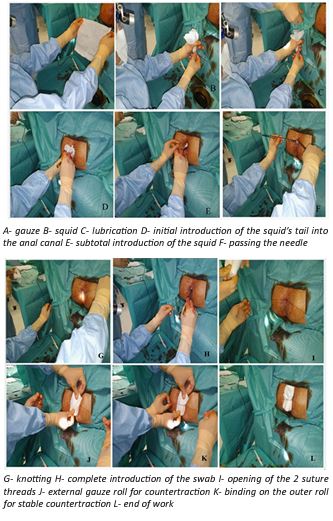Clinical Image - Volume 3 - Issue 1
GPS- Gallese proctological swab
Nando Gallese
UCP-Proctological Surgery Unit, St. Anthony Hospital, Cagliari, Italy.
Received Date : Jan 17, 2023
Accepted Date : Feb 01, 2023
Published Date: Feb 08, 2023
Copyright:© Nando Gallese 2023
*Corresponding Author : Nando Gallese, St.Anthony Hospital, via Chironi 3, 09125 Cagliari, Italy
Email: info@nandogallese.com
DOI: Doi.org/10.55920/2771-019X/1369
Keywords: Anal hemostasis; Surgical bleeding; Proctological Swab; Surgical procedures optimization.
Clinical Image
Objectives: The author has devised and perfected an effective postoperative anorectal tamponade system, very easy, extremely economical and well tolerated by the patient. Material/Method: 2 hemmed sterile gauzes 10x20 cm, 1/0 gauge silk suture, lubricating cream preparation of the “squid” (internal anorectal swab); lubrication of the fringed tail of the swab (tentacles of the squid) and gentle introduction into the anal canal up to the rectal ampulla (where the fringes of the tail open), taking care not to damage the surgical work just performed; finish the introduction leaving 1 cm of the tip of the internal swab (body of the squid) protruding from the anal margin, anchoring the tip of the gauze with a stich in silk and completely internal introduction also of the tip of the swab beyond the margin anal. Preparation of a cylindrical roll of gauze (external tampon) which is placed lengthwise on the posterior perineum, from the anterior to the posterior perianal region (terminal intergluteal sulcus); wrapping of the external tampon with the protruding threads of the internal tampon which are tied tight on the roll with conjunction of the two tampons and creation of an internal/external hemostatic tamponade; in particular cases, the anorectal tamponade maneuver can be completed with external compressive dressing, using “flat” gauze on the roll, anchored with plaster stretched to the skin of the right and left buttocks. Generally the GPS is left with the anchor wire uncut and left long to facilitate the extraction of the internal swab; the removal of the tampon takes place after about 2 hours, when the effects of the subarachnoid anesthesia begin to wear off and the patient feels intolerance from the rectum-anal foreign body; the removal manoeuvre, very simple, is easily performed by the nursing staff with delicate traction on the anchor wires which causes the removal en bloc of the external swab (roll) and the internal one (squid) joined together; in the event of significant bleeding, the swab can be kept in place beyond the limit of 2 hours, even for the entire first postoperative night and removed in the morning under the supervision of the Operating Surgeon: in this case the patient is protected with adequate analgesic therapy.

Conflict of Interest: The Author declare that he has not conflict of interest.
References
- Jennifer C Fuller, David A Shaye. Global surgery: current evidence for improving surgical care. Curr Opin Otolaryngol Head Neck Surg. 2017; 25(4): 300-306.
- Beat Muggli, Antje Lechleite. Surgical proctology - what is common is common. Ther Umsch. 2021; 78(9): 499-507.
- Farquharson SM, Heald RJ. Anal bleeding survey. Lancet. 1994; 344(8924): 751-2.
- LohsiriwatV. World J. Anorectal emergencies. Gastroenterol. 2016; 22(26): 5867-78.

